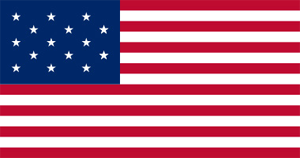War of 1812 Battles |
Colonial Wars |
American Wars |
Battle of Sackett's Harbor
May 29, 1813 at Sackett's Harbor, New York
Books on The Battle of Sackett's Harbor are available from Amazon.com
 |
|||||||||||||||||||||
|
The Battle of Sackett's Harbor was fought in northwestern New York on May 29 during the War of 1812. The battle was a decisive American victory in which a combined force of American militia, regulars and sailors repulsed a British invasion against Sackett's Harbor, New York, the main shipbuilding naval base on Lake Ontario.
During the winter of 1812-13, American Secretary of War John Armstrong asked Commodore Chauncey and Maj. Gen. Dearborn to prepare for an attack on Kingston, the British stronghold on Lake Ontario. The British got wind of the American plan and sent a regiment on an epic thousand-mile snowshoe journey from Fredericton, New Brunswick to Kingston in order to reinforce its garrison. When Chauncey and Dearborn found out, they thought it wiser to attack the lightly-defended York and Fort George instead.
Knowing Chauncey was busy attacking Fort George at the opposite end of Lake Ontario, British commander-in-chief, Sir George Prevost and his Lake Ontario naval commander, Sir James Yeo, decided it was a perfect opportunity to attack Chauncey’s own Sacket’s Harbour base. The new American frigate, the Gen. Pike, was nearing completion and they hoped to destroy it before it ever got launched.
About midday on May 28, the British fleet anchored 6 miles off Sacket’s Harbour. Lacking a pilot familiar with local water depths, Yeo wouldn’t sail any closer. The soldiers climbed into the ships’ boats and started rowing towards the American base, but they didn’t get very far before Prevost, who had spotted boats in the distance and feared they were Chauncey’s, lost his nerve and called them back. Even though the boats’ occupants proved to be only a few dozen American soldiers, the majority of whom the British promptly captured, Prevost dithered till the next morning before finally ordering the attack to resume.
Brig. Gen. Jacob Brown, commanded the Sackett's Harbor defenses. At the time Yeo arrived, he had under his command some 840 regulars, which garrisoned 2 forts gaurding the naval base, Fort Volunteer and Fort Tompkins. The British delay in attacking allowed Brown to call out the local militia units to strengthen the garrison. All afternoon and throughout the night, volunteers poured in to defend Sacket’s Harbour.
Then next morning, May 29, Prevost resumed the attack. Once the British landed they quickly routed the first line on defense, which was mostly militia units in a time of the war when the American militia units had not been turned into an effective fighting force like they were to become in 1814. The second line of defense proved to be more stubborn. Using several blockhouses as cover, the defenders held up the British for nearly two hours, before retiring within Fort Volunteer and Fort Tompkins. From behind its thick walls, the Americans fired heavily at the British. Since Yeo still wouldn’t bring his ships to within range of his guns, the British had no way of breaching the redoubt’s walls. Prevost had little choice but to order a retreat.
The British made a flanking maneuver and marched through the town of Sackett's Harbor, New York and past the naval yard. Fearing that the British may capture the base, the Americans set fire to some of the base and the newly built USS General Pike. Once inside the fortifications, the American defenders continued the battle and the British who were taking on casulties by this time could not breach the fort. Commodore Yeo still refused to bring his ship within range for support, insisting on staying out of range of the fort's artillery. With little hope against the defenses the British withdrew. The British withdrew back to the ships under fire, although the defenders made no pursuit.
The British forces withdrew from Sackett's Harbor. The Americans themselves had already set the General Pike on fire, together with their shipyards, and all the naval stores at the base. Unfortunately for the British, the General Pike, being made of green timber, failed to burn completely and the Americans were later able to salvage it. The part of the shipyard that was set on fire did cause the American navy some setbacks in the upcoming campaigns. The Americans celebrated the British failure to breach the redoubt as a major victory, but their shipbuilding program had in fact suffered a major setback. Yet it did remain in American hands thanks in part to the capable leadership of Brown.
